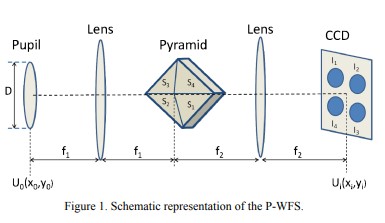Pyramidal Wavefront Sensor Demonstrator at INO
ABSTRACT
Wavefront sensing is one of the key elements of an Adaptive Optics System. Although Shack-Hartmann WFS are the most commonly used whether for astronomical or biomedical applications, the high-sensitivity and large dynamic-range of the Pyramid-WFS (P-WFS) technology is promising and needs to be further investigated for proper justification in future Extremely Large Telescopes (ELT) applications. At INO, center for applied research in optics and technology transfer in Quebec City, Canada, we have recently set to develop a Pyramid wavefront sensor (P-WFS), an option for which no other research group in Canada had any experience. A first version had been built and tested in 2013 in collaboration with NRC-HIA Victoria. Here we present a second iteration of demonstrator with an extended spectral range, fast modulation capability and low-noise, fast-acquisition EMCCD sensor. The system has been designed with compactness and robustness in mind to allow on-sky testing at Mont Mégantic facility, in parallel with a ShackHartmann sensor so as to compare both options.
1. INTRODUCTION
The Pyramid wavefront sensor (P-WFS) is an evolution of the standard Foucault knife-edge test to allow a quantitative estimation of the spatial derivative of the wavefront distortion. It was first proposed by Ragazzoni1 in 1996 and since then successfully implemented on large telescopes AO systems like the one at LBT2.
In comparison with the Shack-Hartmann wavefront sensor, the P-WFS claims better sensitivity3 , greater adaptation to the correcting wavelength, seeing conditions and brightness of the source thanks to the possibility to change the spatial sampling and gain during operation by binning on the detector and variation of the amplitude of modulation. Unlike the SH-WFS, which uses small-aperture micro-lenses to sample the telescope pupil, a P-WFS is only limited by diffraction effects introduced by the whole telescope aperture. It offers more range in limiting magnitude because it is less affected by aliasing at the bright end and it is more sensitive at the faint end than a SH-WFS. The principle of operation of the P_WFS will be described in Section 2.
On the other hand, the need for dynamic modulation can be a disadvantage because it requires a moving component at high frequency inside the instrument. Also the very nature of the pyramid prism can introduce chromatic aberrations and limit the wavelength spectral range of the WFS. In Section 3 we present the preliminary phase set-up built at INO4 in order to gain experience with the concept of P-WFS. Results of the first phase will also be briefly recalled. The second iteration (still ongoing at the time of redaction of this paper) with an extended spectral range, fast modulation capability and low-noise, fast-acquisition EMCCD sensor will be discussed in Section 4.
2. PRINCIPLE OF OPERATION
The principle of operation is shown in Figure 1. Four images of the entrance pupil – itself conjugate to the telescope pupil – are produced by a pyramid-shaped prism onto the detector by means of a telecentric lens system. Modulation of the pupil by means of a tip-tilt mirror is key to obtaining the quantitative information on the wavefront distortion and telecentricity of the system ensures that pixels remain co-registered in the four pupil images in the detector plane as the pupil is modulated.

Для продолжения чтения вы можете скачать полную версию материала по ссылке ниже